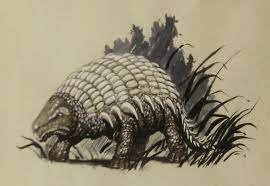
In the intricate tapestry of prehistoric life, certain dinosaur stand out as remarkable enigmas, offering insights into the diverse array of creatures that once roamed our planet. Palaeoscincus, a nodosaurid dinosaur, is one such intriguing figure. While not as well-known as some of its dinosaur counterparts, Palaeoscincus holds a special place in the story of Earth's ancient inhabitants.
Palaeoscincus made its debut onto the paleontological stage in the late 19th century, when fossilized remains were unearthed in North America. Its name, derived from Greek and Latin roots, translates to "ancient skink," a reference to its reptilian nature. These fossils, consisting of fragmentary skeletal elements, allowed scientists to begin piecing together the puzzle of this prehistoric creature.
| Name: | Palaeoscincus dinosaurs |
| Size: | Around 15 feet long and weighing several hundred kilograms. |
| Main Facts: | Palaeoscincus is a nodosaurid with bony armor plates for protection, revealing adaptations for survival in its ancient environment. |
As a nodosaurid, Palaeoscincus belonged to a subgroup of armored dinosaurs characterized by their bony armor plates, or osteoderms, that covered their bodies. These plates provided protection against potential predators and contributed to their distinctive appearance. The arrangement of these osteoderms and the structure of its limbs are among the key features that define Palaeoscincus.

While specific details about Palaeoscincus's diet remain speculative, its dental and skeletal adaptations offer insights into its potential feeding habits. Nodosaurids like Palaeoscincus were herbivorous, using their sharp beaks to crop vegetation. The unique configuration of its jaws and teeth likely allowed it to efficiently process plant material, contributing to its survival in the diverse ecosystems of the Cretaceous period.
Palaeoscincus inhabited the ancient landscapes of North America during the Late Cretaceous, approximately 85 to 65 million years ago. Fossil discoveries place it within a range of environments, from lush forests to open plains, where it shared its habitat with a variety of other dinosaurs and prehistoric creatures.
As a nodosaurid, Palaeoscincus played a role in the intricate web of interactions within its ecosystem. Its armored exterior offered protection against potential predators, allowing it to occupy a unique ecological niche. Its presence likely influenced the behavior of predators and the distribution of plant resources, contributing to the balance of prehistoric life.
The study of Palaeoscincus contributes to our understanding of the paleoenvironmental conditions of its time. By analyzing the sediments and rock formations in which its fossils are found, researchers can reconstruct aspects of the ancient landscapes, including climate, vegetation, and the broader ecological context.
Despite its fragmented fossil record, Palaeoscincus continues to inspire scientific curiosity. Ongoing research involves advanced imaging techniques, comparative analyses, and the application of cutting-edge technology to unlock more details about its anatomy, behavior, and evolutionary relationships.
Palaeoscincus, a nodosaurid dinosaur from the Late Cretaceous of North America, possessed a distinctive appearance marked by bony armor plates known as osteoderms that covered its body. These protective plates, along with its stout limbs and robust build, provided defense against potential predators. Its herbivorous diet is inferred from its beak-like jaws and dental adaptations for cropping vegetation. While its exact size remains uncertain due to fragmentary fossils, Palaeoscincus is believed to have inhabited a range of environments, from forests to plains.
Its existence offers insights into the ecological interactions of the Cretaceous period and contributes to our understanding of armored dinosaur adaptations and their role in prehistoric ecosystems.
Palaeoscincus's bony armor plates set it apart as a nodosaurid dinosaur. Comparisons with other nodosaurids, like Ankylosaurus, reveal variations in armor arrangement, thickness, and defensive strategies. Studying these differences provides insights into how nodosaurids adapted to different environments and potential threats.
Comparing Palaeoscincus to other herbivorous dinosaurs, such as sauropods or hadrosaurs, highlights variations in feeding adaptations. Palaeoscincus's beak-like jaws and dental structure for cropping vegetation differ from the specialized teeth of other herbivores, demonstrating niche partitioning and competition for plant resources.
Comparisons with other Late Cretaceous dinosaurs found in North America, like Triceratops or Tyrannosaurus rex, reveal potential interactions and predator-prey relationships. Palaeoscincus's armor and size may have influenced its interactions with contemporaneous carnivores and other herbivores.
Comparing Palaeoscincus's estimated size and proportions with other dinosaurs provides insights into its locomotion, growth rates, and potential life history traits. Contrasting its body plan with different dinosaur groups informs our understanding of the evolution of body sizes and shapes.
Comparisons with dinosaurs from different environments, such as those from other continents or earlier time periods, highlight adaptations to specific niches. Palaeoscincus's presence in Late Cretaceous North America contributes to our understanding of how nodosaurids diversified in different regions.
Comparing Palaeoscincus with other dinosaurs found in the same rock formations provides clues about shared habitats, plant communities, and environmental conditions. These comparisons assist in reconstructing the ancient ecosystems in which Palaeoscincus thrived.
Studying Palaeoscincus's relationships within the nodosaurid group and comparing it to related dinosaurs contributes to our understanding of the evolutionary history and diversity of armored dinosaurs.
Comparisons with other dinosaurs found in similar preservation conditions inform our knowledge of taphonomy, or the processes that led to fossilization. Analyzing preservation biases helps researchers interpret the fossil record more accurately.